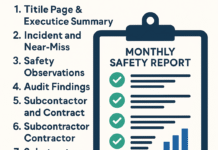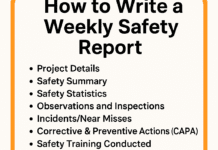
Safe Operating Procedure for Bar Bending Machine
Safe Operating Procedure for Bar Bending Machine : Bar bending machines are pivotal in the construction industry, streamlining the process of shaping reinforcement bars. However, their efficient use necessitates strict adherence to safety protocols to prevent accidents and ensure worker well-being.
Introduction to Bar Bending Machines
In the construction realm, bar bending machines automate the process of bending reinforcement bars to precise angles and shapes required for structural integrity. While these machines significantly enhance productivity, their operation demands strict safety measures to mitigate potential risks.
Understanding the Risks Involved
Operating bar bending machines involves inherent risks. Accidents can result from various factors, including improper handling, lack of training, and equipment malfunction. Understanding these risks is crucial to implementing effective safety protocols.
Safety Precautions Before Operation
Before commencing work with a bar bending machine, a thorough inspection of the equipment and its surroundings is imperative. Equally important is the use of appropriate safety gear, including gloves, goggles, and helmets, to minimize potential injuries.
Step-by-Step Safe Operating Procedures
Executing safe procedures involves correctly setting up the machine, ensuring it’s calibrated accurately, and handling materials with caution. Adhering to precise operational guidelines minimizes the likelihood of accidents.
Regular Maintenance and Inspection
Routine maintenance checks are pivotal for machine longevity and operator safety. Regular inspections identify potential issues, allowing for timely repairs and preventing unforeseen malfunctions during operation.
Training and Awareness
Adequate training for machine operators is paramount. Establishing comprehensive training programs and cultivating awareness about safety practices among workers fosters a safety-conscious environment.
Emergency Procedures
Despite precautions, emergencies can occur. Establishing clear protocols for responding to accidents or machine malfunctions is essential. An emergency action plan equips workers to handle unforeseen situations effectively.
Best Practices for Safe Operation
Implementing best practices, such as periodically reviewing safety protocols, encourages a proactive approach to safety. Regularly updating and enhancing procedures contributes to a safer work environment.
Legal and Regulatory Compliance
Adhering to relevant laws and regulations ensures compliance with safety standards. Employers and employees must understand their responsibilities to maintain a safe workplace.
Case Studies and Examples
Real-life incidents underscore the significance of following safety procedures. Examining case studies emphasizes the repercussions of neglecting safety guidelines.
Safe Operating Procedure for Bar Bending Machine
- Preparation:
- Ensure the work area is clear of obstacles.
- Check the bar bending machine for any visible damage or faults.
- Wear appropriate personal protective equipment (PPE) like gloves, goggles, and safety shoes.
- Machine Setup:
- Power on the machine and let it warm up to the operational temperature.
- Adjust the bending rollers and guides as per the dimensions of the reinforcement bars.
- Ensure the machine’s emergency stop button is easily accessible and functional.
- Material Handling:
- Lift the reinforcement bars carefully and place them in the machine’s feeding mechanism.
- Ensure the bars are aligned properly with the bending rollers to prevent jams or misalignment.
- Operating the Machine:
- Start the machine and feed the reinforcement bars through the bending rollers slowly and steadily.
- Monitor the bending process to ensure the bars are bending accurately as per the required specifications.
- Avoid overloading the machine by bending excessive amounts of bars at once.
- Post-Operation:
- Once bending is completed, switch off the machine.
- Remove the bent bars carefully from the machine’s output.
- Conduct a final check of the machine and the work area for any potential hazards or loose components.
- Maintenance and Clean-Up:
- Regularly clean the machine after use to remove debris and dust.
- Perform routine maintenance tasks as per the manufacturer’s guidelines.
- Store the machine in a designated area, ensuring it’s secured and not obstructing walkways.
- Training and Awareness:
- Provide comprehensive training to operators on the safe use of the bar bending machine.
- Educate personnel about emergency procedures and the importance of following safety protocols.
- Reporting and Feedback:
- Encourage employees to report any machine malfunctions or safety concerns immediately.
- Implement a feedback mechanism to continuously improve the operating procedure based on experiences and suggestions.
Remember, this procedure should align with the specific guidelines provided by the manufacturer and any regulatory requirements in your region. Regular inspections, proper training, and adherence to safety protocols are crucial for safe operation.
Impact of Ignoring Safety Protocols
Neglecting safety measures can have severe consequences, leading to injuries, financial losses, and reputational damage. Stories of accidents due to oversight serve as cautionary tales.
Continuous Improvement and Adaptation
Continual improvement in safety protocols is essential. Incorporating feedback and making necessary adjustments contributes to evolving safety measures.
Promoting a Safe Work Environment
Fostering a culture that prioritizes safety requires collective efforts. It involves promoting awareness, encouraging open communication, and valuing each individual’s contribution to maintaining a safe workplace.
Challenges and Solutions
Identifying challenges in implementing safety measures allows for proactive solutions. Overcoming barriers ensures a more robust safety framework.
Conclusion
Ensuring safe operating procedures for bar bending machines is indispensable in the construction industry. Prioritizing safety through meticulous protocols, regular training, and a collective commitment to a secure working environment safeguards both workers and productivity.
Safe Operating Procedure for Working at Height
Safe Operating Procedure (SOP)
7 Types of Permit To Work (PTW)
FAQs
- Why are safety procedures crucial when operating bar bending machines? Safety procedures mitigate risks, preventing accidents and ensuring worker well-being.
- What safety gear is essential when using a bar bending machine? Gloves, goggles, helmets, and appropriate attire are vital for operator safety.
- How often should bar bending machines undergo maintenance checks? Regular inspections are recommended to identify potential issues and ensure safe operation.
- Are there legal implications for not following safety protocols? Non-compliance with safety regulations can result in legal consequences and financial liabilities.
- How can a company encourage a safety-conscious culture in the workplace? By conducting regular training, promoting awareness, and involving employees in safety initiatives.





















